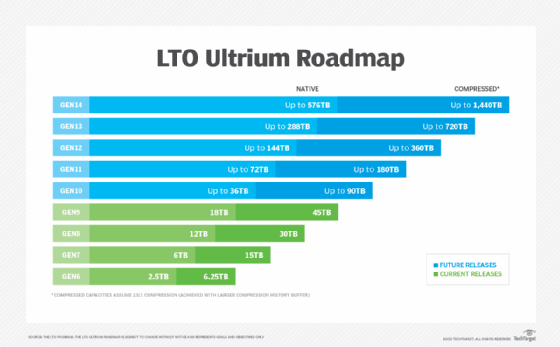LTO-7 (Linear Tape-Open 7)
What is LTO-7 (Linear Tape-Open 7)?
LTO-7 is a tape format from the Linear Tape-Open (LTO) Consortium released in late 2015. It succeeded the LTO-6 version, which launched in 2012.
Other earlier versions included LTO-1, LTO-2, LTO-3, LTO-4 and LTO-5. LTO-7 is currently followed by LTO-8 and LTO-9, with five more versions projected to launch in the future.
LTO-7 capacity and speed
An LTO-7 cartridge offers 15 terabytes of compressed capacity, sustained data transfer rates of up to 750 megabytes per second for compressed data, uncompressed capacity of 6 TB and an uncompressed transfer rate of 300 MBps.
LTO-7 capacity and data transfer rates assume a 2.5:1 compression ratio. The LTO compression algorithm is lossless.
One LTO-7 cartridge can store up to 800 high-definition movies, according to the LTO Consortium. LTO-7 capacity can hold the data of up to five LTO-5 cartridges.
Comparing native data transfer rates, tape is faster than a typical hard drive that offers 130 MBps. The transfer rate for LTO-7 is almost twice as fast as that of an LTO-6 tape drive.
Technology enhancements, including stronger magnetic properties and a doubling of read/write heads, helped increase the capacity and data transfer rates.
Barium ferrite has replaced other metal particle coatings on LTO cartridges and has demonstrated the potential of providing capacities of up to 220 TB -- uncompressed -- per cartridge.
Important features in LTO-7
Like LTO-5 and LTO-6, LTO-7 offers partitioning; encryption; and the write once, read many (WORM) feature.
In 2005, LTO-3 added the WORM capability, which enables compliance with legal record-keeping regulations and reduces the risk of data loss from human error. Data cannot be altered, rewritten or erased.
In 2007, LTO-4 added the ability to encrypt data before it is written to tape with the 256-bit Advanced Encryption Standard (AES)-Galois/Counter Mode.
In 2010, LTO-5 added partitioning, which enabled the Linear Tape File System (LTFS) to be integrated. Partitioning reserves a portion of the tape for indexing, which tells the drive exactly where in the tape a file is stored. The second partition holds the actual file.
Use cases for LTO
Though tape has lost favor to disk as a primary and backup storage medium, it remains well suited for long-term storage and archiving because of its high capacity, low cost, durability and portability.
As data continues to grow exponentially, tape is commonly used by industries such as entertainment and the sciences, which can create huge volumes each day and need a place for storage at a lower cost than disk.
While disk can enable quicker recovery of data, tape presents a strong choice for security in an age of cyberattacks, such as ransomware. Tape provides offline data protection, keeping data isolated from networks that are susceptible to viruses. In addition, tape stored off-site presents an option for disaster recovery if a primary data center is compromised by a natural disaster or human-caused problem.
LTO-7 has a durability of 30 years. No electricity is required to preserve data stored on tape, thus saving energy and money.
Previous LTO generations and compatibility
Hewlett Packard, now HPE; IBM; and Seagate, which later sold its tape business to Quantum, formed the Linear Tape-Open Consortium in the late 1990s. The consortium typically releases a new generation of LTO every two to three years.
LTO-1 was the first version of the LTO magnetic tape data storage technology to serve as an open standard alternative to the available formats of the day. It has 100 gigabytes (GB) of native capacity and a native transfer speed of 20 MBps.
Each of the next three versions of LTO doubled the native capacity, bringing the LTO-4 version to 800 GB.
The introduction of LTO-5 raised native capacity to 1.5 TB and data transfer rates up to 140 MBps with a 2:1 compression ratio.
LTO-6 offers 2.5 TB native capacity -- 6.25 TB compressed -- with native sustained data transfer rates as high as 160 MBps and compressed sustained data transfer rates up to 400 MBps. Starting with LTO-6, the capacity and data transfer rates both assume 2.5:1 compression ratios.
An LTO tape drive through generation 7 can read tapes from its own generation and two prior generations, and it can write to tapes from its own and one previous generation. For example, LTO-7 drives can read LTO-5, LTO-6 and LTO-7 tapes, and write to LTO-6 and LTO-7 tapes.
LTO-8 is fully backward compatible with LTO-7 cartridges, which marked a change from previous versions that could read back two generations.
Since LTO specifications are open format, they provide interoperability among competing vendors. The open tape format offers intellectual property licenses to potential manufacturers. That competitive environment can lead to faster innovation and more improvements.
Vendors submit products for compatibility testing to ensure an LTO tape from one vendor can be used on a tape drive from another. However, LTO products are not compatible with non-LTO products.
Linear Tape File System
LTFS enables LTO technology to be indexed. An LTO tape drive reads the indexing information and presents it in a format that enables organizations to drag and drop files to and from tape, like with disk. LTFS improves user access through search and retrieval tools.
LTO is still a serial recording device, so an organization can only access data at the end of a tape after running through its entire length.
LTFS is compatible with LTO-5, LTO-6, LTO-7, LTO-8 and LTO-9. Users can download software that enables their operating system to recognize LTFS.
Future LTO specifications
The LTO Consortium has since released LTO-8 and LTO-9. As of 2024, none of the projected future formats have launched. The projected specifications for each format are as follows:
- LTO-10 is slated to offer 36 TB of uncompressed capacity and 90 TB compressed.
- LTO-11 is projected to provide 72 TB of uncompressed capacity and 180 TB compressed.
- LTO-12 is expected to feature 144 TB of uncompressed capacity and 360 TB compressed.
- LTO-13 is expected to feature 288 TB of uncompressed capacity and 720 TB compressed.
- LTO-14 is expected to feature 576 TB of uncompressed capacity and 1,440 TB compressed.
The new generations are expected to continue to support LTFS, WORM and AES encryption.

LTO-8 uses tunnel magnetoresistance, which provides a more defined electrical signal than the previous giant magnetoresistance, causing bits to be written to smaller areas of media. As a result, TMR has increased capacity projections over the next few LTO generations.





